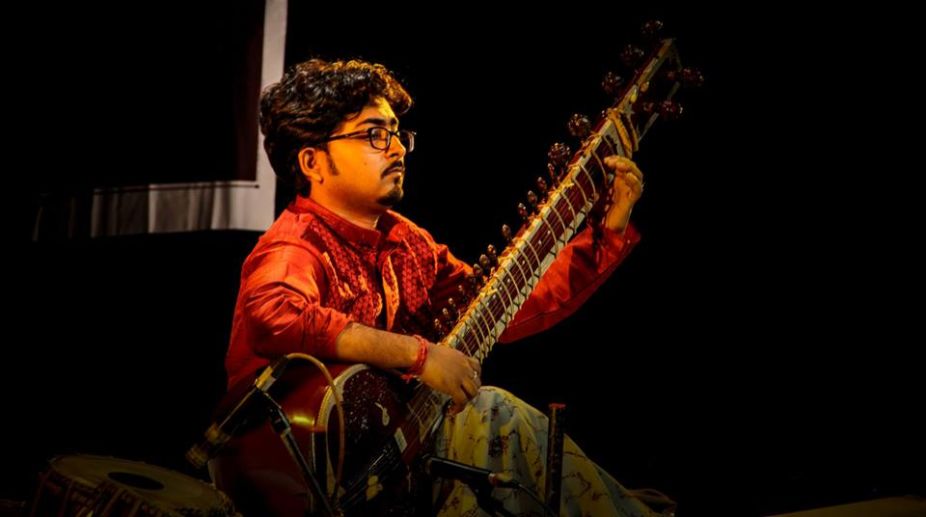The bygone bardic battles of Bengal
Far more than a mere musical pursuit, Kabi Gaan boasts an illustrious heritage, its roots firmly embedded in the fertile soil of 18th century-Bengal’s rural landscape.

Deepsankar Bhattacharjee (Photo: Facebook)
Dhwani, under the melodious stewardship of Deepsankar Bhattacharjee, organised Triveni, a difficult endeavour and a unique idea that brought brilliant representatives of three different sitar gharanas on one platform, one after the other at Satyajit Ray Auditorium. Difficult, because this is an era when the term “global village” is a reality due to easy access to all possible ideas and their free intermingling; and as such loyalty-bound strict adherence to gharana-values, in any sphere of life, is almost next to impossible.
In this regard one needs to remember that as an old tradition, the gharana system of music was very strict and, apparently, each gharana was named after a specific city/village where the master lived and students studied. The absence of mass transportation and communication ensured the survival of these strict practices along with secrecy related to their uniqueness.
Triveni stood out as unique because all the three young sitar maestros, Subhranil Sarkar (Etawah Gharana), Soumalya Chakraborty (Senia Maihar Gharana) and Deepsankar Bhattacharjee (Indore Gharana’s Jafferkhani baaj), who participated in the evening’s proceedings, strived to showcase the exclusivity of their style of playing as handed down to them by their legendary mentors who were not averse to new ideas. In fact they re-interpreted their gharana’s traditional values in the light of innovations that changed the total panorama of music making in the arena of sitar playing.
Advertisement
Subhranil Sarkar, as the final artiste of the event, chose to play raga Bihag replete with compositions of Ustad Imdad Khan (the founder of the gharana), Ustad Vilayat Khan (the legendary maestro who infused khayal vocalism in sitar and took this style to dizzying heights) and his Guru, Ustad Shahid Parvez (the sultan of sitar of his generation). Both Vilayat Khan and Shahid Parvez remained influenced by Ustad Amir Khan’s gayaki. Its unmistakable effect was perceivable in the alap played by Sarkar in which the notes were allowed to linger till the sound ebbed completely and effective pauses linked the intimately-played soft phrases. The mukam-based rhythmic phrases of jod progressed note by note and the jhala showcased varied patterns of chikari playing.
Sandip Ghosh, a renowned tabla exponent who is very much in demand as an accompanist, helped in making the slow-medium paced rupak, medium sitarkhani and fast teental gatkaris delightful by giving suitable replies to the taan-tihais of varied designs and by filling the gaps with solo rounds.
Earlier, the packed to capacity hall saw the evening commence with the strains of raga PuriaKalyan, played by Soumalya Chakraborty, disciple of Pandit Kushal Das who is deeply influenced by the legendary Nikhil Banerjee, an ardent admirer of Ustad Amir Khan’s inimitable vocalism. The reposeful playing of alap by Chakraborty represented that stream of Maihar gharana, which is very different from Pandit Ravi Shankar’s ornate tantrakari; instead it adhered to meend-laden, pathos-ridden and vocalism-based intimate soft tone that was simple yet very effective. The jod segment also retained this quiet mood apart from a few ornate phrases with bol and krintan and a few very neat taans, and closed softly, without tihai.
In keeping with the mood, Arindam Chakraborty’s perceptive tabla entered very quietly to join in with sitar’s jhaptal gatkari (a Maihar gharana trait that popularised gat playing in various talas apart from teental or ektal). The exchange of rhythmic play between the two further ripened when they landed on fast teental. The clarity of fast taans was delightful. These led to jhala that had meditative alap and perky taans in its fold and ended with a tihai.
Despite the difference in their sitar, its tuning process and techniques of playing, the impression of Amirkhani introspective mood, especially in the alap segment, remained pleasantly common in both those musicians’ recital.
That was not so with Deepsankar Bhattacharjee who preferred to be sandwiched between his peers’ recital and with an entirely different aural effect — born out of his extremely ornate and complex Jaffarkhani baaj. This son-disciple of Pandit Harashankar Bhattacharya (groomed by none other than Ustad Abdul Haleem Jaffer Khan), caught hold of his raga Jaijaiwanti, with its most effective key-phrase right in the beginning. Instead of a leisurely progress, he chose the path strewn with krintan, ghasit, lahek et al linked with meend and punctuated with mohra and very soon started crafting gamak and thhonk taans interspersed with emotion-charged melodic sentences. In keeping with gharana tradition there was no jhala and a simple gat-bandish in slow teental beckoned Prasanta Dey Roy’s tabla to join in.
Bhattacharjee focused on intricate rhythm-play at times with harmonised melody and then moved on to another sitarkhani gat to showcase taans of varied designs. Each ornate phrase was cushioned with emotive sentence — a very intelligent melodic plan of this young musician. The jhala, at high speed, explored the upper reaches before turning to taans of varied chhand emphsised by thhonk and finally closed with a neat tihai.
This enjoyable evening could touch edifying heights if the physical differences of the sitars and differentiating characteristics of the gharana techniques were explained for the benefit of listeners. Compere Somdutta Bhattacharjee stringed the recitals with warmth.
Advertisement